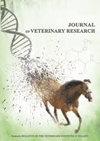波兰山羊群中肝包虫病的流行情况
IF 1.3
3区 农林科学
Q2 VETERINARY SCIENCES
引用次数: 0
摘要
肝吸虫又称普通肝吸虫,是一种分布于全球的吸虫,给反刍动物造成了巨大的经济损失。波兰的牛和绵羊都会感染肝吸虫,但对山羊感染肝吸虫的情况却知之甚少。因此,我们对波兰山羊进行了血清学和共显微镜调查,以确定波兰山羊群体中肝包虫病的感染率。 2014 年至 2022 年期间,在波兰根据 GLOWORM 项目框架内开发的空间分布模型估计肝包虫感染风险增加的地区,对随机抽取的 33 个山羊群进行了血清学筛查。几乎所有成年山羊(1 岁以上)都使用商用 MM3-SERO ELISA 进行了检测。通过或然率表分析了羊群血清阳性的风险因素。此外,还采用沉淀法检测了 214 个监测胃肠道线虫感染和抗蠕虫药耐药性的羊群的粪便样本。 在 33 个羊群中,有 11 个羊群至少发现了一只血清阳性山羊,表明羊群血清阳性率为 33.3%(95% 置信区间 (CI 95%):19.7%-50.4%):19.7%-50.4%).在动物层面,1,464 只接受检测的山羊中只有 17 只血清阳性(1.2%,CI 95%:0.7%-1.9%)。群内血清阳性率从 0.8% 到 11.1%不等。牛群的血清学状况与牛群的特征或与绵羊的接触程度无明显关联。在位于波兰中部的一个羊群中,发现了一个阳性粪便样本,表明肝包虫病在羊群中的感染率为 0.5%(CI 95%:0.1%-2.6%)。动物死后检查发现肝脏出现了典型的慢性筋膜炎病变。 F. hepatica感染在波兰山羊群体中时有发生,其发病率远低于牛或绵羊。因此,只有通过准确的诊断检测可靠地证实感染了法氏囊病,才应考虑对其进行治疗或预防。这也适用于居住在牛羊似乎普遍感染肝包虫病的地区的山羊,这很可能是由于山羊会避开潮湿的地区。本文章由计算机程序翻译,如有差异,请以英文原文为准。
The herd-level prevalence of Fasciola hepatica infection in the goat population of Poland
Fasciola hepatica, also known as the common liver fluke, is a globally distributed trematode parasite responsible for high economic losses in ruminants. Infection with F. hepatica occurs in Polish cattle and sheep; however, very little is known about its occurrence in goats. Therefore, a serological and coproscopic survey was carried out in Polish goats to determine the herd-level prevalence of F. hepatica infection in the goat population of Poland.
Between 2014 and 2022, 33 randomly selected goat herds were serologically screened in the regions of Poland for which risk of F. hepatica infection was estimated as increased based on the spatial distribution model developed within the frame of the GLOWORM project. Virtually all adult goats (>1 year-old) were tested using a commercial MM3-SERO ELISA. Risk factors for seropositive herd status were analysed in contingency tables. Also, faecal samples from 214 goat herds monitored for gastrointestinal nematode infections and anthelmintic resistance were examined using a sedimentation method.
At least one seropositive goat was detected in 11 of 33 herds, indicating herd-level seroprevalence of 33.3% (95% confidence interval (CI 95%): 19.7%–50.4%). At the animal level, only 17 of 1,464 tested goats were seropositive (1.2%, CI 95%: 0.7%–1.9%). The within-herd seroprevalence ranged from 0.8% to 11.1%. The serological status of the herd was not significantly associated with the characteristics of the herd or the extent of contact with sheep. In one herd, located in central Poland, a single positive faecal sample was found indicating a herd-level prevalence of F. hepatica infection of 0.5% (CI 95%: 0.1%–2.6%). The animal’s post-mortem examination revealed liver lesions typical of chronic fasciolosis.
F. hepatica infection occurs sporadically in Polish goat population and its prevalence is much lower than in cattle or sheep. Therefore, treatment or prevention of fasciolosis should only be considered if it has been reliably confirmed by an accurate diagnostic test. This applies also to goats inhabiting geographical areas where F. hepatica infection appears to be widespread in cattle and sheep, very likely due to the fact that goats avoid wet areas.
求助全文
通过发布文献求助,成功后即可免费获取论文全文。
去求助
来源期刊

Journal of Veterinary Research
Veterinary-General Veterinary
CiteScore
0.90
自引率
5.60%
发文量
58
审稿时长
18 weeks
期刊介绍:
Journal of Veterinary Research (formerly Bulletin of the Veterinary Institute in Pulawy) is a quarterly that publishes original papers, review articles and short communications on bacteriology, virology, parasitology, immunology, molecular biology, pathology, toxicology, pharmacology, and biochemistry. The main emphasis is, however, on infectious diseases of animals, food safety and public health, and clinical sciences.
 求助内容:
求助内容: 应助结果提醒方式:
应助结果提醒方式:


